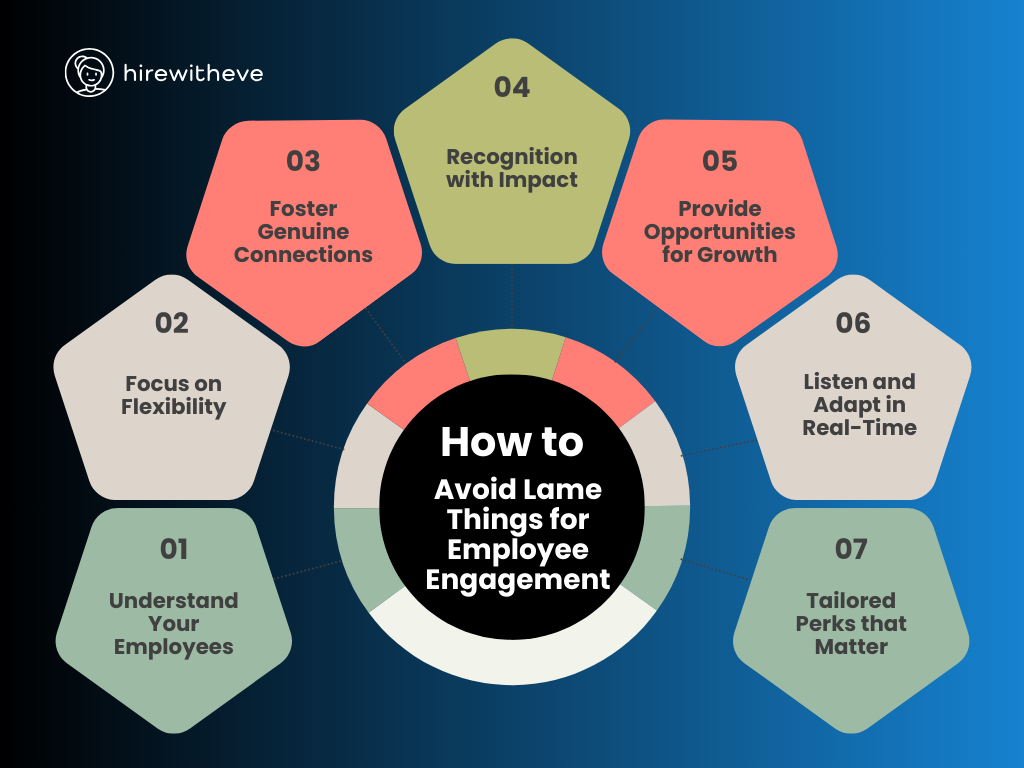Lame Things for Employee Engagement
Lame Things for Employee Engagement

Employee engagement is a crucial part of retaining top talent and ensuring productivity. However, many well-meaning HR teams and talent acquisition specialists end up implementing strategies that, rather than engaging employees, fall flat. These lame things for employee engagement can damage morale and make employees feel less valued. This blog will discuss some of the most common lame approaches to engagement and how you can avoid them, focusing on the tools and features of platforms like HirewithEve that can streamline the process and make it meaningful.
Table of contents
Lame Things for Employee Engagement: What HR Gets Wrong
Examples of Lame Things for Employee Engagement
The Consequences of Lame Employee Engagement Strategies
How to Avoid Lame Things for Employee Engagement: Practical Solutions
How HirewithEve Can Help Streamline Employee Engagement?
Conclusion
Lame Things for Employee Engagement: What HR Gets Wrong
When it comes to employee engagement, well-intentioned HR teams often end up implementing strategies that feel superficial and fail to resonate with employees. This disconnect often leads to a category of practices we call lame things for employee engagement. These efforts are typically born out of a misunderstanding of what truly motivates and engages employees or from simply following trends without real analysis.
Common Pitfalls in Employee Engagement:
Surface-Level Activities: Many HR managers assume that by organizing activities like team-building exercises or after-work events, they are fostering engagement. However, if these activities don't align with employee’s interests or work-life balance, they can feel more like a burden than a benefit. For example, holding a mandatory Friday night happy hour might be well-received by a few, but others may resent the imposition on their time.
Over-Reliance on Rewards Programs: Generic rewards, such as gift cards or points-based systems, can feel impersonal. When employees feel like the same rewards are being given out regardless of individual contributions, these programs quickly become another example of lame things for employee engagement. Employees begin to see these rewards as trivial, which can lead to disengagement.
Overcompensation through Perks: Companies sometimes offer flashy perks like game rooms or catered meals, thinking that these will engage employees. But, these perks don’t address core concerns like career growth, workload management, or recognition of hard work. Perks alone rarely lead to sustained engagement if the foundational elements of respect and growth are lacking.
Forced Participation: Whether it’s surveys, group activities, or wellness initiatives, forcing employees to participate against their will can backfire. While these initiatives aim to give employees a voice or improve morale, when they feel forced or disingenuous, they become yet another lame thing for employee engagement.
By understanding these pitfalls, HR teams can avoid implementing tactics that seem to engage but in reality, alienate employees. Real engagement requires going beyond the surface to tap into what employees value in the workplace.
Examples of Lame Things for Employee Engagement
Let’s dive deeper into some of the most common lame things for employee engagement and why they’re counterproductive:
Overhyped Team Building
While the idea of team-building exercises sounds good in theory, over-hyping them often leads to awkward participation. Employees want meaningful, not manufactured, connections. Overdone team-building is one of the classic lame things for employee engagement.
Surface-Level Wellness Programs
Offering free gym memberships without addressing work-life balance is another example of lame things for employee engagement. These programs may look good on paper but don’t improve employee well-being.
Mandatory Surveys
Surveys are supposed to give a voice to employees, but making them mandatory and not acting on the feedback turns them into one of the many lame things for employee engagement. Employees quickly recognize when their input isn’t genuinely valued.
One-Size-Fits-All Perks
Perks that don’t align with individual employee needs or preferences become another lame thing for employee engagement. Offering perks that employees don’t care about results in disengagement.
The Consequences of Lame Employee Engagement Strategies
Implementing lame things for employee engagement doesn’t just result in wasted time and resources — it can actively harm your organization. When employees detect that engagement efforts are hollow or insincere, the backlash can be significant and multifaceted. Let’s explore the common consequences of poorly executed engagement strategies:
Reduced Morale and Productivity
When employees sense that engagement initiatives are simply for show, they become disengaged. For example, if employees are forced into "fun" team-building exercises that don’t resonate with them, they may not only avoid participation but also develop a negative attitude towards future company initiatives. In this way, lame things for employee engagement can chip away at overall morale. This disengagement can affect their productivity, as employees who don’t feel valued or motivated are less likely to put in their best effort.
Increased Turnover
When employees are disengaged, they’re more likely to start looking for other opportunities. High turnover can become a huge cost for companies, both in terms of time and resources. If your engagement strategies are misaligned, employees may conclude that your organization doesn’t care about their real needs, prompting them to seek out employers who will.
Negative Word of Mouth
In today’s interconnected world, employees talk — whether it’s in person or online. When engagement strategies feel phony or forced, word spreads fast. Former employees might share their negative experiences on platforms like Glassdoor or through personal networks, deterring potential talent from joining your company. The spread of these stories can tarnish your company’s employer brand, making it harder to attract top-tier candidates in the future.
Disengaged Employees Spread Disengagement
Disengaged employees don’t exist in a vacuum. Their negative energy can spill over into team dynamics, affecting the mood of others and spreading discontent across entire departments. If a significant portion of your workforce feels that engagement efforts are lame, it can lead to a culture of widespread disengagement, where negativity feeds on itself.
Lack of Trust in Leadership
When employees see that leadership consistently pushes engagement strategies that don’t resonate, trust in the organization’s leadership starts to erode. Employees begin to believe that leadership is out of touch with their needs and realities, which can affect long-term loyalty and satisfaction.
The result of implementing lame things for employee engagement is not simply ineffectiveness — it can actively contribute to a dysfunctional and demoralized workforce. If HR professionals and talent acquisition specialists fail to recognize and adapt, they risk creating an environment where disengagement becomes the norm.
How to Avoid Lame Things for Employee Engagement: Practical Solutions
Avoiding lame things for employee engagement requires a shift in how you approach engagement altogether. Here’s what you can do:
Avoiding lame things for employee engagement requires a thoughtful and employee-centric approach. Engagement strategies need to be customized, genuine, and responsive to the needs of employees rather than built on generic practices.
Here’s how HR teams can avoid the most common engagement pitfalls and build authentic, effective engagement programs.

Understand Your Employees:
The first step to creating effective engagement programs is to listen to your employees. Engagement shouldn’t be about what you think your employees want but what they value. A comprehensive employee survey, focus groups, or one-on-one discussions can help uncover the real motivators in your workforce. It’s important to act on the insights you receive — doing surveys without follow-through is just another example of lame things for employee engagement.
Focus on Flexibility:
Today’s workforce, especially following the global shift toward remote work, values flexibility. Engagement strategies that fail to offer this will be perceived as out of touch. Employees want control over their work schedules, location, and work-life balance. Offering remote work options, flexible hours, or a hybrid model shows employees that you trust them and value their well-being. Instead of the old lame things for employee engagement, like mandatory office events, offer employees the chance to decide how and when they engage.
Foster Genuine Connections:
Building real relationships among employees is key to engagement, but it can’t be forced. Instead of obligatory team-building exercises, create opportunities for organic connection. This could be through interest-based groups, casual meetups (virtual or in-person), or collaborative projects. Engagement thrives when people feel they’re building meaningful relationships rather than being forced into interactions.
Recognition with Impact:
Recognizing employees for their work is critical, but it needs to feel genuine. Programs like “Employee of the Month” can feel competitive and shallow, especially if the same individuals receive the recognition repeatedly. Instead, create systems of recognition that are fair, transparent, and personal. Publicly acknowledging contributions in meetings or offering individual rewards based on specific achievements shows that you value each employee’s unique efforts.
Provide Opportunities for Growth:
Career development is one of the biggest drivers of employee engagement. Offering clear pathways for growth, skill development, and advancement within the company fosters long-term engagement. Training programs, mentorship, and stretch assignments can show employees that you’re invested in their future. Instead of focusing on lame things for employee engagement, such as reward points or swag, invest in opportunities that help employees build skills and progress in their careers.
Listen and Adapt in Real-Time:
Engagement isn’t something you can set and forget. It’s a dynamic aspect of workforce management that requires constant listening and adaptation. Tools that gather real-time feedback, such as pulse surveys, can help you gauge how employees are feeling in the moment. Most importantly, be prepared to act on that feedback quickly. If employees express dissatisfaction with a program or strategy, adjust it before it becomes another example of lame things for employee engagement.
Tailored Perks that Matter:
It’s tempting to follow the latest trends in perks and benefits, but what’s important is providing perks that your specific workforce values. Instead of trendy perks like free snacks or a ping-pong table, offer things that make a real difference in employees’ lives, such as flexible PTO, childcare support, or student loan repayment assistance. These perks may not seem flashy, but they address the actual needs of your workforce, creating a deeper connection and engagement.
How HirewithEve Can Help Streamline Employee Engagement?
At this point, you’re probably wondering how a platform can help avoid the common traps of lame things for employee engagement.
HirewithEve offers several key features that align perfectly with today’s needs:
Skills-Based Hiring: The platform emphasizes the importance of hiring based on skills rather than just credentials or past job titles. This approach allows employers to find candidates who are a better fit for specific roles, especially in industries where specific skill sets are crucial.
Remote Hiring Support: Given the shift towards remote work, the platform likely includes features that help companies find and hire the best talent from anywhere worldwide, breaking down geographical barriers.
ATS (Applicant Tracking System) Integration: HirewithEve might offer integration with ATS platforms to improve the efficiency of the hiring process, making it easier for HR teams to track and manage candidates.
Analytics and Insights: The platform may offer analytics features to provide insights into hiring trends, candidate performance, and the effectiveness of various hiring strategies.
These features ensure that your employee engagement efforts are effective, meaningful, and well-received.
Conclusion
At the end of the day, HR teams must prioritize genuine engagement over outdated and superficial tactics. By focusing on what employees truly want — personalized recognition, flexibility, growth opportunities, and meaningful connections — you can avoid lame things for employee engagement that drive employees away.
HirewithEve is the right platform to help you achieve these goals. Its customizable engagement tools, real-time feedback mechanisms, and data-driven insights can ensure that your efforts are productive and well-received.
Target Your Talent
Unlock tailored solutions for your recruitment and hiring needs with Eve Platform's extensive case study library.
Subscribe now to enhance your HR expertise and excel in your role.
Free Resources

Transforming Hiring: 7 Key Recruiting Metrics
Enhancing recruitment processes with data-driven insights for better hiring outcomes.

Reducing Hiring Bias with Hirewitheve.
Utilizing Hirewitheve to combat bias and streamline recruitment processes effectively.

Hiring Detail-Oriented Candidates
HirewithEve enhances hiring by accurately assessing candidate's attention to detail-oriented.
